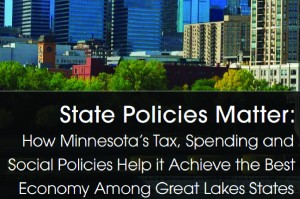
In an interview with Bridge magazine University of Michigan President Mark Schlissel lays out the case for public investments as essential to the future success of Michigan. Particularly public investments in higher education. Schilissel says:
It used to be the public would come together around common goods, things that, you know, no individual benefits from, but we all benefit from collectively if we all chip in. We’ve gotten away from that notion. So it’s a question of making investments for the future. And I think we [Michigan] are failing to do that.
… So consistently through the decades, public higher ed has been starved. We’re not alone. Other states have been similarly short-sighted in their approach to the role of education in the future economic success of the state.
And it’s not just education. Look at how we’re paralyzed now in a discussion over the roads. It’s absolutely clear from multiple independent sources how much it’s going to cost to get our roads back to the condition that they should be and then to keep them that way. The problem is quite similar to the problem with higher ed: Nobody wants to pay for things. They think that there’s a magic way of squeezing efficiency out of bureaucracies, of moving money around using clever financial management tricks, and then nobody has to pay. And obviously, that’s silly.
Silly indeed. Michigan Future for years has documented that the most prosperous states––except those that are energy driven––are state that have made public investments the centerpiece of their economic strategy, rather than low taxes.
The New York Times article on Texas that we explored in our last post and a recent Wall Street Journal article on southern states lagging over the last decade are two more examples of the failure of low taxes as a path to prosperity.
Schlissel proposes that public investments in higher education be done through funding college students rather than the institutions. He says:
I’ve tried a new argument this year with the Legislature, and it hasn’t been any more successful [than past arguments]. The argument is, rather than necessarily giving more money to the universities, perhaps it would be more popular if we gave the money to the students. Based on need, we’ll give you a subsidy, a scholarship. If you’re a student at a certain [income] level, we’ll provide you with X number of thousands of dollars, and you spend it at the school that you think is going to give you the best education.
And that way, instead of being concerned about having too many students that can’t pay, the public universities compete for these students, which is a wonderful thing. And the kids will vote with their feet where they think they’re going to get the best value for this money.
The state of California does this. It’s basically pegged to the full tuition at the public universities in the state. It adds up to about $11,000 or $12,000 a year and it’s based on academic performance and financial need. We [the state of Michigan] are, as in many things, near the bottom of all the states in direct-to-student financial aid. We’re 47th in the country in the amount of [college aid] per capita.
This is an idea we advanced in our 2006 A New Agenda for a New Michigan. We wrote:
As we assess the assets Michigan has to prepare, retain, and attract talent, our higher education system rises to the top of the list. Michigan has spent decades building a world-class system of higher education, both universities and community colleges. They are arguably the most important assets we have in developing the concentration of talent we need to be successful in a knowledge-based economy. That is particularly true of our major research universities.
So the single most important thing policy makers can do for the future economic success of Michigan and its regions is to ensure the long-term success of a vibrant and agile higher education system.
… What we need from policy—and are not getting—is a commitment to insure a system of higher education that is world-class in (1) preparing students for success in a flat world, and (2) contributing to new knowledge creation.
We need a new approach to state support for higher education, one that will give us a better chance of maintaining a high-quality and agile system of higher education for decades to come. We propose a new structure for state support of higher education. It would have three components:
• Institutional independence at public universities and community colleges.
• Provide state funding to students, no matter where they come from, rather than to institutions.
• Provide a substantial state match for federal research funding.
More specifically we proposed:
With autonomy, institutions will control their revenue based on their ability to compete in the marketplace. The state’s role should be to make higher education more affordable to students. We believe this is a terrific—probably the best—investment for the future economic success of the state. So, the higher proportion of tuition paid by the state, we believe the better for the state’s future. The reality is, given the state’s chronic structural deficit, there is almost no chance of a substantial increase in higher education funding without a tax increase.
We recommend a single fund that would take the place of all state funding for higher education (including merit scholarships and capital outlays) and would provide students with a voucher/foundation grant.
Imagine if we had implemented this approach to higher education over the last 13 years. We would have substantially fewer students leaving college because of the inability to afford college and far less students paying off high student loans. But most importantly we would have a far higher concentration of those with a four-year degree or more, which as we should have learned from neither metro Detroit or metro Grand Rapids making the final 20 list for Amazon’s HQ2, is the key to attracting high-wage employers.
Let’s hope our current policymakers heed the advice of President Schlissel and we don’t let another 13 years go by and continue on a path to making Michigan permanently a low-prosperity state.







